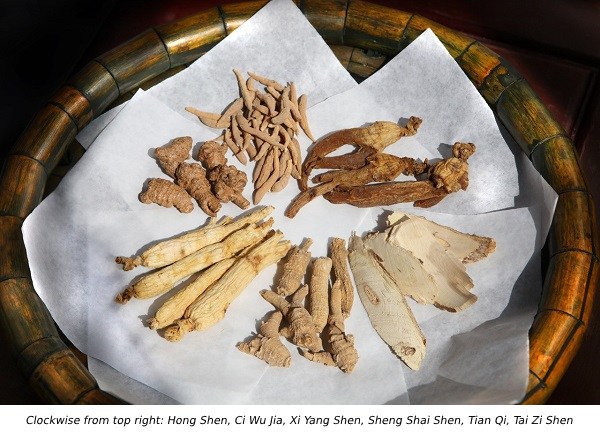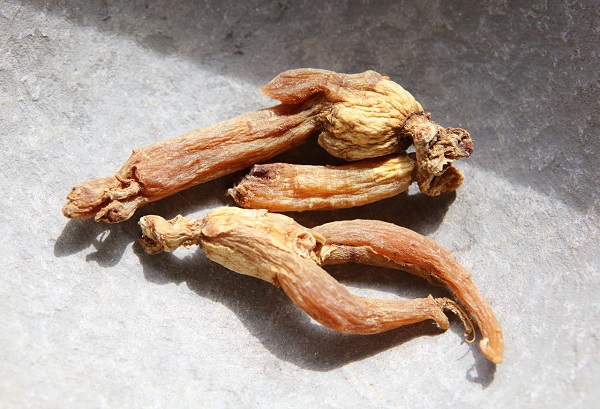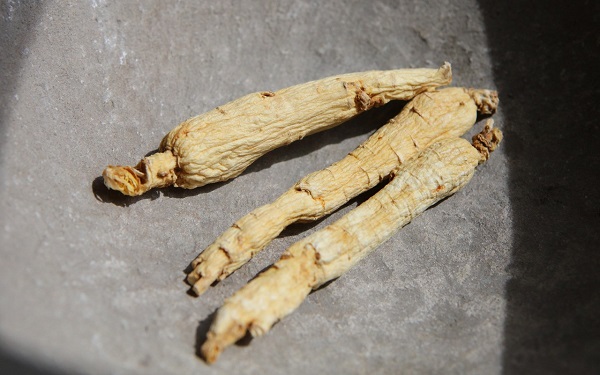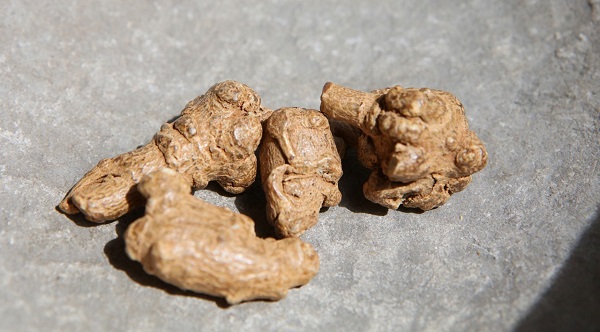Finding the Right Ginseng
Put black truffles or wild morels in a recipe that calls for buttons and you will have a very different outcome, even though they are all called mushrooms. Ginseng is arguably one of the most well-known Chinese medicinal herbs, yet the word is casually used to refer to many different herbs, some with slight variations and others with completely different actions. Let’s take a look at all the “ginsengs” and the differences between them.

The Panax Family and True Ginsengs
The genus name "Panax" is derived from the Greek, and means “cure all” or panacea, and within that genus are several species that we use in Chinese medicine.
Ren Shen / Chinese and Korean ginseng
Panax ginseng is the botanical name for this deciduous perennial with a thick fleshy root. It is native primarily to northern China and Korea where it grows along a mountain range that is split between those countries. The roots are grown for a minimum of 5 years before they are ready to be harvested. The Chinese name, Ren Shen, translates as “man root” for the sometimes human-like appearance of the root.
Best known to TCM practitioners as the strongest Qi tonic herb, Ren Shen powerfully tonifies the Yuan-primary Qi of all five Yin organs; it particularly tonifies the Spleen and Lung Qi, benefits the Heart and calms the Shen. It also tonifies the Yin and generates body fluids. Through the strong tonification of Qi, Ren Shen also has a strong effect on the Blood; it generates Blood, gently encourages the proper movement of Blood, and controls bleeding.
- Ye Shan Shen, or “wild mountain ginseng” is the wild-growing form, and considered to be the most potent. However, it is now so scarce it is prohibitively expensive (and ecologically irresponsible) to harvest, so it is only used in the most severe cases of Qi deficiency or collapse, if at all. These roots may be grown 10+ years before harvesting
- Sheng Shai Shen, or “fresh dried ginseng,” also known as white ginseng, is best for simultaneously tonifying Qi and nourishing Yin fluids, and is often used in China as a substitute for Xi Yang Shen (info below). After harvest, it is cleaned, rootlets are removed, and sundried or dried on indoor drying racks. Indoor drying is preferable, as the sun may bleach the root to an attractive pale-yellow color, but may also reduce the therapeutic actions.
- Bai Shen “white ginseng” or Tang Shen “sugar ginseng” are roots punctured with needles along the entire root, soaked in sugar water, then dried or left moist. Some sources say that they best used for mild Qi and Yin deficiency, particularly of the Spleen and Stomach. However, other sources say that this “White Sugar Root” are made from smaller inferior roots basically plumped up with the sugar water. The soaking in sugar water actually leaches out some of the ginsenosides, and make them tastier, but therapeutically inferior. These sources consider them a slightly tonifiying, ready-to-eat snack at best, and advises closer inspection if one is wanting to purchase Sheng Shai Shen since both are sometimes referred to as “white ginseng”.
-
 Hong Shen, or red ginseng, is warmer and best for Qi and Yang deficiency. It is processed by heating and steaming. In “The Pharmacologically Active Constituents of White and Red Ginseng Root” authors Dennis V. C. Awang, PhD, FCIC and Michael Z. C. Li, MD, MSc state that “The steaming process also converts original ginsenosides to partially deglycosylated derivatives that have enhanced anti-cancer activity (e.g., ginsenosides Rg3, Rg5, and Rh2). Korean-grown ginseng is generally processed this way, which is said to make the herb more potent.
Hong Shen, or red ginseng, is warmer and best for Qi and Yang deficiency. It is processed by heating and steaming. In “The Pharmacologically Active Constituents of White and Red Ginseng Root” authors Dennis V. C. Awang, PhD, FCIC and Michael Z. C. Li, MD, MSc state that “The steaming process also converts original ginsenosides to partially deglycosylated derivatives that have enhanced anti-cancer activity (e.g., ginsenosides Rg3, Rg5, and Rh2). Korean-grown ginseng is generally processed this way, which is said to make the herb more potent. - Shen Xu, the “ginseng whiskers” or rootlets have a lesser tonifying effect compared to the main and lateral roots. However, different studies have mentioned that more often than not, the rootlets have much higher levels of ginsenosides than the main roots, and sought after for standardized ginsenosides extracts.

Dong Yang Shen / Japanese ginseng
This is actually a sub-species, identified as Panax ginseng japonica, but has different therapeutic effects due to a different growing environment in Japan. Translating to “eastern root”, its actions are more similar to Xi Yang Shen/American ginseng, not as warming as Ren Shen/Chinese ginseng.
There is also a subspecies Panax ginseng vietnamensis, recently found being grown in central Vietnam, and regarded as a new botanical species. According to research from 2000, "It has been used in traditional folk medicine in hill tribes for the purpose of anti-fatigue and life-saving."
Xi Yang Shen / American ginseng
While in the same family, Xi Yang Shen is a different species from the above varieties, called Panax quinquefolium. It is well known to have a stronger Yin tonifying action and lesser Qi tonifying function than Ren Shen. As such, while Xi Yang Shen does not have the strong tonifying effects on the Yuan-source Qi that Ren Shen does, it does have a stronger effect of tonifying the Heart, Lung and Kidney Yin. It also clears heat from the Intestines and stops bleeding. While we have just one name for this herb in TCM, which translates to “western seas root”, colloquially it is also known as Hua Qi Shen, “flowered flag {American} ginseng” and there are also several forms available.
- Wild American ginseng is native to the Appalachian mountain region of the U.S. Wild plants are harvested after 8-10 years of growth. It is currently listed as a threatened species due to over-harvesting of the plants, but some states still allow a short open harvest season.
- Woods-grown American ginseng is cultivated within the forest, mounding the dirt to increase production, yet keeping the plant within its native environment. These plants are harvested after 6-8 years of growth.
- Cultivated American ginseng is grown under tarps in fields, primarily in Canada and Wisconsin. This technique yields crops in 3-4 years.
Tian Qi / Notoginseng root

Tian Qi is in the same genus as the ginsengs, but a different species called Panax notoginseng, and sometimes known as “pseudo ginseng.” However, Tian Qi has very different functions and indications from all the other herbs listed here. In the “Stop Bleeding” category, Tian Qi is famous for being able to simultaneously stop bleeding and invigorate the Blood. Indicated for bleeding due to Blood stasis obstructing the passageways and forcing the Blood out of the Blood vessels, Tian Qi can safely stop bleeding without causing further buildup of Blood stasis. Conversely, it can invigorate the Blood without causing more bleeding. Tian Qi is an excellent Die Da (trauma) herb, useful in reducing swelling and alleviating pain in addition to invigorating the Blood and stopping bleeding. It is often used to treat menstrual problems involving bleeding and/or Blood stagnation. Prepared or cooked San Qi is known for a lessened ability to invigorate the Blood and stop bleeding, but an added ability to gently tonify the Blood.
Other Genera: False Ginsengs
Ci Wu Jia / “Siberian ginseng”
Although Ci Wu Jia is a part of the larger ginseng family, Araliaceae, it is not a species of true ginseng, or Panax ginseng. Originally called "Siberian ginseng" to promote its similarities to the functions of ginseng, nowadays this herb is usually called Eleuthero, and is recognized as a completely separate species. Its botanical name is Acanthopanax senticosus, although it is more often referred to as Eleutherococcus senticosus. While still categorized as a Qi tonic, it is much milder and has slightly different actions than Ren Shen. Where Ren Shen excels at tonifying the Yuan Qi, Lungs and Spleen, Ci Wu Jia focuses on tonifying the Spleen and Kidney. Like Ren Shen, it is also used to calm the Shen. However, Ci Wu Jia does not tonify body fluids or Blood like Ren Shen. Recently, Ci Wu Jia has been used as a strong immune tonic and has been patented in the drug "Endurox" to increase physical endurance.
Tai Zi Shen / “Prince ginseng”
Tai Zi Shen, Pseudostellaria heterophylla, is not even a part of the larger ginseng family, Araliaceae, and therefore not a species of ginseng at all. However, its Chinese name translates to “Prince Ginseng” and it has many of the same actions and indications as ginseng, but is milder and of a neutral temperature, and therefore considered a safer substitute for younger patients and children. Tai Zi Shen is a Qi tonic, and like Ren Shen it can generate Body Fluids and tonify Yin – particularly of the Lung, Spleen and Stomach. Although less strong than Ren Shen or even Dang Shen as a Qi tonic, it is known to be a good long-term and gentle tonic for convalescing after an illness, stopping Spleen deficient loose stools, and tonifying the Lungs to stop chronic cough.
Sources:
- Chinese Herbal Medicine Materia Medica by Dan Bensky & Andrew Gamble
- Chinese Medical Herbology and Pharmacology by John K. Chen & Tina T. Chen
- Wikipedia entry on Ginseng: https://en.wikipedia.org/wiki/Ginseng
- New York State Dept. of Environmental Conservation Ginseng pages: http://www.dec.ny.gov/animals/7130.html
- Pao Zhi: An Introduction to the Use of Processed Chinese Medicinals by Philippe Sionneau and Bob Flaws
- Bioactive saponins in vietnamese ginseng, panax vietnamensis, Yamasaki K. Published in Pharm Biol. 2000;38 Suppl 1:16-24. doi: 10.1076/phbi.38.6.16.5956. PMID: 23531134 https://www.ncbi.nlm.nih.gov/pubmed/23531134
- Extract of ciwujia (Acanthopanax senticosus) which is the active ingredient in Endurox, a tradename, used to enhance Physical Endurance; it contains ciwujianosides D1 and C1.
Substance Name: Acanthopanax senticosus, ext. RN: 92346-80-0 https://chem.nlm.nih.gov/chemidplus/rn/92346-80-0 - Wild Panax ginseng (Panax ginseng C.A. Meyer) protects against methotrexate-induced cell regression by enhancing the immune response in RAW 264.7 macrophages, Jang HI, Shin HM. Am J Chin Med. 2010;38:949–960. https://www.ncbi.nlm.nih.gov/pubmed/20821825

